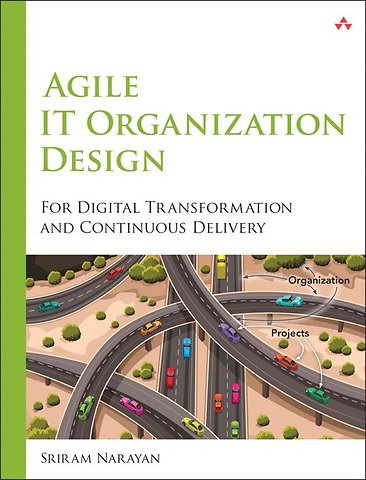Agile IT Organization Design
Why Digital Transformation and Continuous Delivery Efforts Need It
Paperback Engels 2015 1e druk 9780133903355Samenvatting
Design IT Organizations for Agility at Scale
Aspiring digital businesses need overall IT agility, not just development team agility. In 'Agile IT Organization Design', IT management consultant and ThoughtWorks veteran Sriram Narayan shows how to infuse agility throughout your organization. Drawing on more than fifteen years’ experience working with enterprise clients in IT-intensive industries, he introduces an agile approach to “Business–IT Effectiveness” that is as practical as it is valuable.
The author shows how structural, political, operational, and cultural facets of organization design influence overall IT agility—and how you can promote better collaboration across diverse functions, from sales and marketing to product development, and engineering to IT operations. Through real examples, he helps you evaluate and improve organization designs that enhance autonomy, mastery, and purpose: the key ingredients for a highly motivated workforce.
You’ll find “close range” coverage of team design, accountability, alignment, project finance, tooling, metrics, organizational norms, communication, and culture. For each, you’ll gain a deeper understanding of where your organization stands, and clear direction for making improvements.
Ready to optimize the performance of your IT organization or digital business? Here are practical solutions for the long term, and for right now.
- Govern for value over predictability
- Organize for responsiveness, not lowest cost
- Clarify accountability for outcomes and for decisions along the way
- Strengthen the alignment of autonomous teams
- Move beyond project teams to capability teams
- Break down tool-induced silos
- Choose financial practices that are free of harmful side effects
- Create and retain great teams despite today’s “talent crunch”
- Reform metrics to promote (not prevent) agility
- Evolve culture through improvements to structure, practices, and leadership—and careful, deliberate interventions
Trefwoorden
agile it organisatieontwerp teams digitale transformatie business-it alignment cross-functionele teams continuous delivery devops verantwoordelijkheid organisatie matrixorganisatie waarde-gedreven governance silo's intrinsieke motivatie waardestromen projectmanagement financieel management metrieken communicatie capex versus opex besluitvorming digitale business personeelsmanagement budgettering gemeenschappen van praktijk normen cultuur outsourcing shared services capaciteitsplanning
Trefwoorden
Specificaties
Lezersrecensies
Inhoudsopgave
U kunt van deze inhoudsopgave een PDF downloaden
Acknowledgments
About the Author
Glossary
1: Context
1.1 Focus
1.2 Business, IT, and Shadow IT
1.3 Business-IT Effectiveness
1.4 Digital Transformation
1.5 Bimodal IT and Dual Operating Systems
1.6 Angles of Coverage
1.7 Summary
2: The Agile Credo
2.1 Understanding the Agile Manifesto
2.2 Continuous Delivery and DevOps
2.3 Agile Culture
2.4 Common Themes
2.5 Isn’t Agile Dead?
2.6 Summary
3: Key Themes
3.1 Software Development Reconsidered
3.2 Govern for Value over Predictability
3.3 Organize for Responsiveness over Cost-efficiency
3.4 Design for Intrinsic Motivation and Unscripted Collaboration
3.5 Summary
4: Superstructure
4.1 Business Activities and Outcomes
4.2 Centralization and Decentralization
4.3 Silos
4.4 Summary of Insights
4.5 Summary of Actions
5: Team Design
5.1 Framing the Problem
5.2 Activity-oriented Teams
5.3 Shared Services
5.4 Cross-functional Teams
5.5 Cross-functionality in Other Domains
5.6 Migrating to Cross-functional Teams
5.7 Communities of Practice
5.8 Maintenance Teams
5.9 Outsourcing
5.10 The Matrix: Solve It or Dissolve It
5.11 Summary of Insights
5.12 Summary of Actions
6: Accountability
6.1 Power and Hierarchy
6.2 Balance Autonomy with Accountability
6.3 Assign Accountability
6.4 Minimize Power Struggles
6.5 Decide on an Outcome Owner
6.6 Migration
6.7 Decision Accountability
6.8 Planning and Execution
6.9 Org Chart Debt
6.10 Summary of Insights
6.11 Summary of Actions
7: Alignment
7.1 Articulate Strategy for General Alignment
7.2 Aligning IT with Business
7.3 Structural Alignment
7.4 Making Business Play Its Part
7.5 Summary of Insights
7.6 Summary of Actions
8: Projects 109
8.1 What Is Wrong with Plan-driven Software Projects?
8.2 Budget for Capacity, Not for Projects
8.3 Business-capability-centric IT
8.4 Project Business Cases
8.5 Value-driven Projects
8.6 Project Managers
8.7 Governance
8.8 Change Programs and Initiatives
8.9 Summary of Insights
8.10 Summary of Actions
9: Finance
9.1 Relevance
9.2 Cost Center or Profit Center
9.3 Chargebacks
9.4 CapEx and OpEx
9.5 Conventional Budgeting
9.6 Agile Budgeting
9.7 Summary of Insights
9.8 Summary of Actions
10: Staffing
10.1 Dealing with the Talent Crunch
10.2 Go Beyond Project Teams
10.3 Better Staffing
10.4 Summary of Insights
10.5 Summary of Actions
11: Tooling
11.1 Access Control for Unscripted Collaboration
11.2 Subtle Effects of the Toolchain
11.3 Technology Isn’t Value Neutral
11.4 Tool Evaluation 1
11.5 Summary of Insights
11.6 Summary of Actions
12: Metrics
12.1 Metrics Don’t Tell the Whole Story
12.2 Dashboards Promote Ignorance
12.3 The Problem with Targets and Incentives
12.4 Reforming the Metrics Regime
12.5 Designing Better Metrics
12.6 Objections to Metrics Reform
12.7 Migration
12.8 Summary of Insights
12.9 Summary of Actions
13: Norms
13.1 What Are Norms?
13.2 Reinforcing Norms
13.3 Cooperation over Competition
13.4 Living Policies
13.5 Consistency over Uniformity
13.6 Ask for Forgiveness, Not for Permission
13.7 Confidential Surveys
13.8 Balance Theory and Practice
13.9 Summary of Insights
13.10 Summary of Actions
14: Communications
14.1 Intrinsic Motivation
14.2 Interpersonal Communications: Problems 1
14.3 Interpersonal Communications: Mitigation
14.4 Scaling Employee Engagement through Internal Communications
14.5 Deliberating in Writing
14.6 The Use and Misuse of Visual Aids
14.7 Documents, Reports, and Templates
14.8 Summary of Insights
14.9 Summary of Actions
15: The Office
15.1 Open-plan Layouts
15.2 Ergonomics
15.3 Remote Working
15.4 Summary of Insights
15.5 Summary of Actions
16: Wrap-up
16.1 Summary of Effects
16.2 Order of Adoption
16.3 Information Radiators
16.4 Sample Exercise
16.5 IT Services
16.6 GICs
16.7 Beyond IT
Bibliography
Index
Anderen die dit boek kochten, kochten ook
Rubrieken
- advisering
- algemeen management
- coaching en trainen
- communicatie en media
- economie
- financieel management
- inkoop en logistiek
- internet en social media
- it-management / ict
- juridisch
- leiderschap
- marketing
- mens en maatschappij
- non-profit
- ondernemen
- organisatiekunde
- personal finance
- personeelsmanagement
- persoonlijke effectiviteit
- projectmanagement
- psychologie
- reclame en verkoop
- strategisch management
- verandermanagement
- werk en loopbaan







